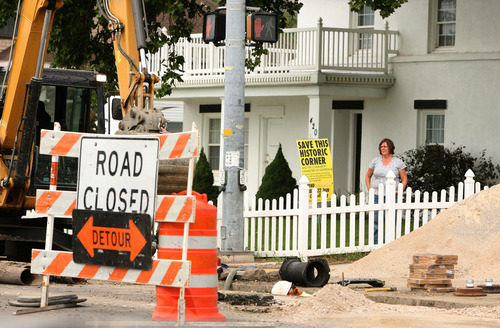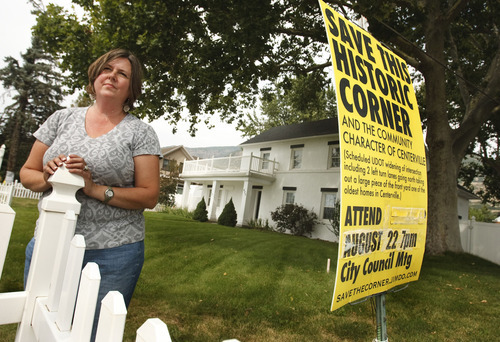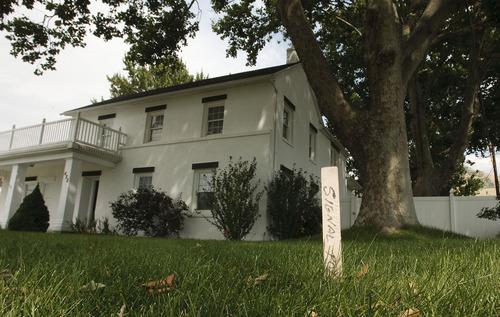This is an archived article that was published on sltrib.com in 2012, and information in the article may be outdated. It is provided only for personal research purposes and may not be reprinted.
Centerville • It wasn't watching sheep fields turn into housing developments that bothered the residents who live in this southern Davis County city's original homes.
It wasn't watching the downtown shopping district explode, or even the construction of a Super Walmart that turned the sleepy town into a bustling commercial area.
The last straw came with a City Council plan to take out about a dozen feet of property from four historic homes' front yards to widen the intersection at Parrish Lane and Main Street. City leaders see a proposed street overhaul as a way to accommodate increased traffic through residential and business areas, but for homeowners, changes that would alter the neighborhood's landscape are more than they can bear.
As the clock ticks for city officials to make a decision on widening the road near homes built in the 1800s, Centerville residents opposed to the plan have gathered hundreds of signatures to save a historic corner of this town of about 15,000.
The city council could choose to do only part of the project, protecting privately owned land and keeping traffic flow at an acceptable level for the next five years. Or, they can spend some earmarked federal money — which may evaporate if not used — and keep traffic moving smoothly for the next 30 years. But that option comes at the expense of part of the front yards of some of the most historic, visible homes in the city.
—
Out with the old? • The homes that start on the northeast corner of Parrish and Main were built by the Parrish family, who arrived in Utah as Mormon pioneers in the 1850s.
In the corner house, at 420 N. Main St., Jennie Parrish Stewart, after whom a local elementary school was named, lived out her years after she was widowed. There are still school desks from the original school where she taught displayed in a hallway alcove.
Walking into the home, now owned as a second residence by Stan Hainsworth, the great-great-grandson of original builders Joel and Elizabeth Parrish, the sense of history is overwhelming. A plaque is proudly displayed, detailing the history of the home. Antique furniture blends with modern children's bedrooms, and the fireplaces hearken back to a day before central heating.
"Our position isn't just to preserve this home, but a sense of history," said Jay Hainsworth, Stan Hainsworth's father who lives directly behind the home with his wife, Norma Parrish Hainsworth. "This is the first residential area people see when they enter Centerville. It's always been a symbol of the old and historical area."
Stan Hainsworth recently updated the home, adding a fresh coat of white paint and fencing in the yard.
If the construction comes through, it will take out 11½ feet of property — down from the Utah Department of Transportation's original plan to remove 17 feet — but still shrinking homeowners' yards. UDOT is involved because Parrish and Main are both State Routes, SR 106 and SR 105. The road would widen in front of the four homes to accommodate two left-turn lanes, and then merge together quickly. UDOT officials are certain that won't cause a bottleneck, but the homeowners are skeptical.
On several of the properties, a historical rock retaining wall will be removed, but the state will pay to install a replacement, said Steve Thacker, Centerville city manager.
"The City Council is weighing the long-term benefit against the impact on these properties," Thacker said. "By all means, they are not flippant at all about the impact on the property owners. They are appreciative and empathize with them, but they are weighing the long-term community issues against the impact these homeowners face."
—
In with the new • Centerville has seen massive changes in the past few decades.The small town boasts a Super Target, Super Walmart, Home Depot, PetSmart and newly relocated and expanded Dick's Market, all accessible from Parrish Lane, along with nearly a dozen eateries lining the street and a Megaplex Theatre capping the west end of the road.
In the past 10 years, higher-density housing developments also have cropped up, but according to U.S. Census data, the city's population has grown only by about 800 people in the past decade.
Farmington, the town that borders to the north, has seen an explosion in population. The city increased in population by 50 percent — from about 12,000 in 2000 to more than 18,000 in the 2010 Census. Most of that occurred on the west side of Farmington, which is easily accessed by the Legacy Parkway. But there is more traffic in Centerville from their northern neighbors.
Alice Fisher Roberts, who lives in one of the historic homes that is slated to lose part of its front yard, said she understands that traffic in the area has increased, and will continue to increase, but she's upset about the city's and state's approach.
"I understand why the city feels like they need to do something, but I'm frustrated that the first option they're looking at involves taking land from homeowners," Roberts said. "I think what is really happening here is that the city has access to federal funding and they're feeling like the kid in the toy store — that they have to buy something now before the money disappears."
The city applied for federal money years ago to help ease the traffic flow in the area. It wasn't slated to receive any funding until 2014, but due to the stimulus package, its funding request was bumped up on the priority list, Thacker said.
The city would receive $1.2 million in federal funds, $350,000 from the state and Centerville taxpayers would pay about $87,000.
—
Two roads diverging • Centerville City Councilwoman Sherri Lindstrom said the choice to expand the roadway near the historic homes is the city's best current option.
"If anyone can bring a plan to get 25 to 30 percent of the about 1,575 households near Main Street into mass transit, I can consider not widening that road," she said. "If not, my hands are tied.
"We've all felt the pain of growth," she said. "None of us like doing this. It's difficult to find a win-win in this situation."
UDOT figures show that if they were to widen the two roads enough to install double turn lanes going both west on to Parrish and north onto Main, it would reduce car wait times by anywhere between 12 to 46 seconds per car and decrease idling emissions.
About 100 people attended council meetings to oppose the decision to widen the road in a way that impacts yards. People suggested other options, too.
"I think traffic, like water, flows the path of least resistance, and that if they made some of the other through streets more accessible or appealing, that we could cut the traffic on Main Street enough to relieve some of the pressure at the Parrish and Main intersection," Roberts said.
Thacker acknowledged that there is enough capacity on Centerville's Frontage Road to handle the traffic, but that drivers rarely take that route because many commuters' homes are farther east.
The Hainsworth family would like to see the city improve the traffic light timing for left turns in that part of the city, near the freeway on- and off-ramps, and improve the surface of the Frontage Road. Roberts, their neighbor, hopes for much of the same.
"I feel like the pioneer homes along Main Street deserve a little more respect, and if we need to improve our traffic situation, we need to find a way to work around what is here and preserve our history," Roberts said. "Otherwise, we become any other small town USA, with our Walmart and crumbling Main Street."
smcfarland@sltrib.comTwitter: @sheena5427 What's next
The Centerville City Council will meet on Tuesday to discuss widening an intersection at Parrish Lane and Main Street.
The meeting is at 7 p.m. at City Hall, 250 N. Main St.







